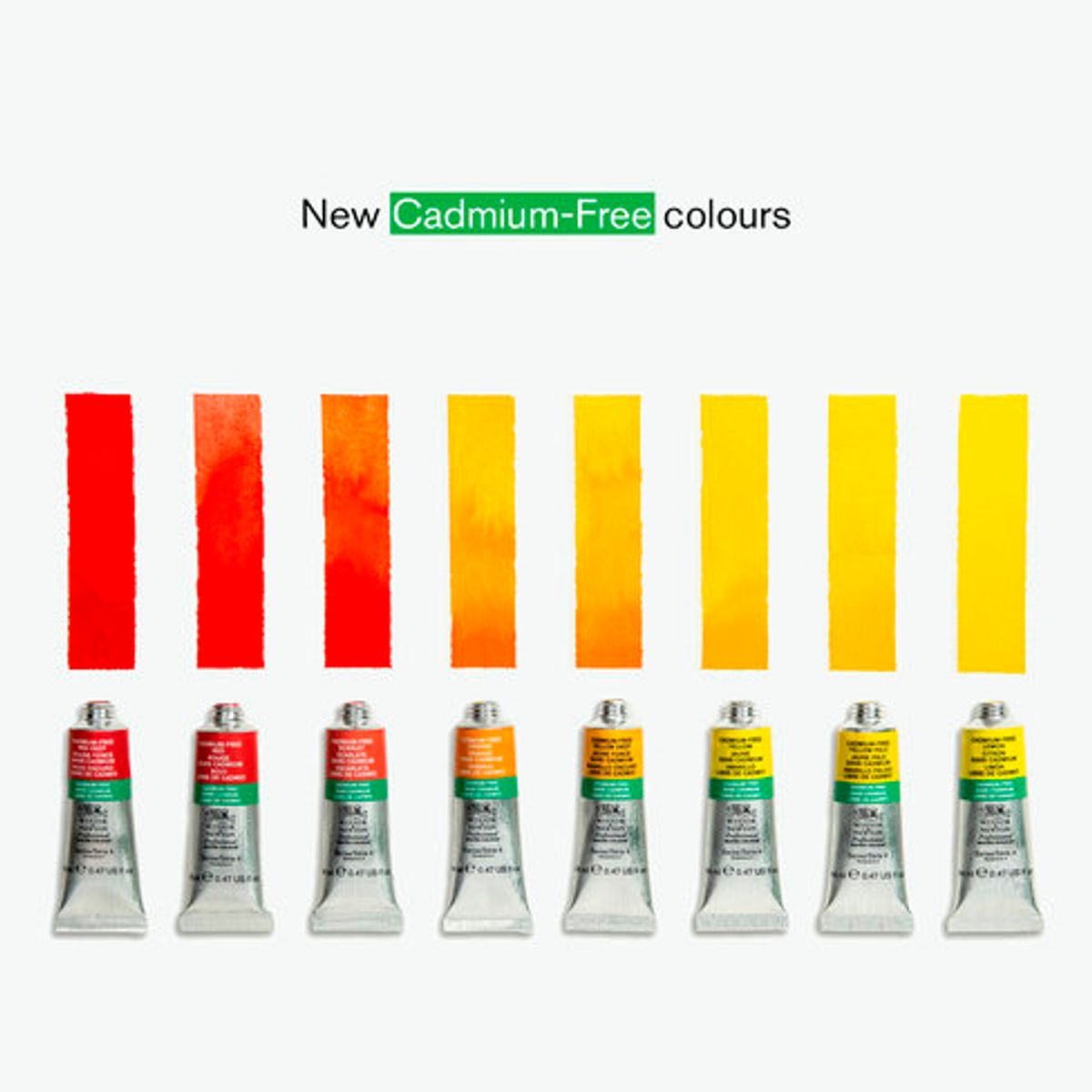
Winsor & Newton has always been at the forefront of innovation, always driven by artists’ needs - from developing the first glycerine-based moist water colours in 1835, to introducing glass syringes to hold oil colour, in place of pigs’ bladders in 1840. The first to publish the composition and permanence of our colours in 1892, we were also the first to launch alkyd oil colours in 1976 and water mixable oil colours in 1998.
2019 sees another Winsor & Newton world first, with the introduction of a new innovation in water colour: the world’s first Cadmium-Free formulas that provide true parity in colour and performance to genuine Cadmium paints. Cadmium pigments are much loved by artists due to their ability to deliver intensely bright, lightfast results. However, Cadmium is a heavy metal and - although there is no globally harmonised view - there are some concerns about its safety. Areas such as California require a warning statement to be shown on every Cadmium paint, while others, such as the EU consider it safe.
Throughout our history we have strived to bring artists an alternative, without compromising on quality or performance. Safety is paramount at Winsor & Newton and we therefore tasked our chemists to create something totally new that would answer the needs of artists who love cadmium colours but had concerns about its impact. Our team have replicated Cadmium’s signatures: its bright masstone, its undertone for subtleties in thin layers, its tinting ability, viscosity, opacity and flow, as well as its archival lightfastness. Plus, to give an authentic experience, the weight of the Cadmium-Free paint in the tube has been carefully matched.
Don’t confuse these with hue colours. Cadmium hues already exist, using a blend of pigments to create something resembling an original Cadmium colour. Winsor & Newton Cadmium-Free water colours are something very different. Each one identically matches the colour of genuine Cadmium and behaves in the same way.
The new Cadmium-Free water colours have been independently tested and certified as safe to use in the studio and within educational settings. This evaluation was carried out by the Art and Creative Materials Institute (ACMI), the international association of art, craft and creative material manufacturers which seeks to promote safety through its certification program. As a member of the ACMI, we use the industry standard product seals on our packaging and materials to communicate safety to our artists. The Approved Product (AP) and Cautionary Labelling (CL) seals indicate that these products have been evaluated by a qualified toxicologist and are labelled in accordance with federal and state laws. Our Cadmium-Free colours hold the AP seal and are completely safe to use. They are certified in a toxicological evaluation by a medical expert to contain no materials in sufficient quantities to be toxic or injurious to humans, including children, or to cause acute or chronic health problems.
What is Cadmium?
The original Cadmium is a rare soft metal, similar to Zinc but much harder to find naturally in the earth. It was only when it was discovered as a by-product of the Zinc refining process, that it became used a commercial pigment.
This discovery took place in 1817 when German chemist, Professor Friedrich Stromeyer, was inspecting pharmacies. The professor noticed a glowing yellow element that was formed when heating Zinc Oxide as part of the medicine preparation process. He named it Cadmium, from the Latin cadmia, meaning Zinc ore calamine, which itself is named after the earth first found near Thebes, a city founded by the Phoenician prince Cadmus.
Production of the Cadmium yellow pigment began in around 1820 and were soon joined by an extended range of yellows and oranges created in the laboratory. The new Cadmium colours, particularly the darker varieties, were more lightfast than existing choices and became a welcome addition to the artist’s palette, eventually being used by Claude Monet and Vincent Van Gogh.
In 1919 a new red pigment joined the Cadmium family. It brought a stable, vibrant red to the palette, replacing Vermilion which would darken over time and contained the toxic element Mercury. Cadmium red has been used widely by artists, from Van Gogh, Monet, Matisse and Mondrian, to Munch and Chagall. Cadmium red was also a staple colour of the Abstract Expressionists including Clyfford Still, Joan Mitchell, Barnett Newman and Ellsworth Kelly, and more recently it can be seen in the palette of the late British artist Howard Hodgkin.
Still loved by many artists for its colour brightness and excellent opacity, Cadmium remains a part of the Winsor & Newton artists’ palette. It is now, however, joined by a Cadmium-Free alternative for those who want it.
Check out the new Cadmium-Free Water Colours (click here).
